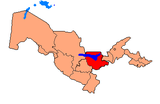Jizzax Region
The regional capital is Jizzakh (pop. 212,689, 2024). Other major towns include Doʻstlik, Gagarin, Gʻallaorol, Paxtakor, and Dashtobod. Jizzakh Region was formerly a part of Sirdaryo Region but was given separate status in 1973.
Economy
The economy of the Jizzakh Region is primarily based on agriculture. Cotton and wheat are the main crops, and extensive irrigation is used. Natural resources include lead, zinc, iron, and limestone. Uzbekistan and China are working together to jointly establish a Special Economic Zone in the region. This high-tech industrial park will be formally established by March 2013. The China Development Bank will provide a $50 million loan to finance several of the joint projects in the construction, agro-industrial and mechanical engineering sectors.
The region has a well-developed transportation infrastructure, with over 2500 km of surfaced roads.
Geography
The climate is a typically continental climate, with mild winters and hot, dry summers.
The Zaamin National Park, formerly Guralash Reserve, on the western slopes of the Turkestan Range and known for its unique fauna and flora, is also within the region.
Wildlife is extremely rich here; in spring and in summer, alpine meadows are with a multitude of colors: bright-red tulips and snow-white acacias. In autumn the hills are magnificently decorated with the gold-colored domes of the hazelnut trees, columns of birch-trees, towering plane trees, and green thickets. High in the mountains, in the upper part of the Guralashsoy gorge, is a nesting-place of black storks. These rare birds are the pride and joy of Uzbekistan. They are written down in the "Redbooks" in many countries as an endangered species. Early in the spring when the Arnasoy depression is flooded, flocks of ducks, wild geese, pelicans and grey herons are found here. This territory serves as a nesting place for rose-coloured starlings, shrikes, and sandpipers.
Districts

The Jizzakh Region consists of 12 districts (listed below) and one district-level city: Jizzakh.
| Key | District name | District capital |
|---|---|---|
| 1 | Arnasoy District | Gʻoliblar |
| 2 | Baxmal District | Oʻsmat |
| 3 | Doʻstlik District | Doʻstlik |
| 4 | Forish District | Bogʻdon |
| 5 | Gʻallaorol District | Gʻallaorol |
| 6 | Sharof Rashidov District | Uchtepa |
| 7 | Mirzachoʻl District | Gagarin |
| 8 | Paxtakor District | Paxtakor |
| 9 | Yangiobod District | Balandchaqir |
| 10 | Zomin District | Zomin |
| 11 | Zafarobod District | Zafarobod |
| 12 | Zarbdor District | Zarbdor |
There are 6 cities (Jizzakh, Gʻallaorol, Doʻstlik, Dashtobod, Gagarin, Paxtakor) and 42 urban-type settlements in the Jizzakh Region.
Demographics
Permanent population
The permanent population of Jizzakh region was 1,352,100 at the January 1, 2019, grew by 27,100 people or increased by 2.0%. Urbanisation was 46.9% (634,300 cities population and 53,1% or 717,800 rural population) in the beginning of 2019.
Analysis by district shows that the largest population was in Sh. Rashidov district of 213,000 inhabitants (15.8% of population) and in Jizzakh city with 174,000 inhabitants (12.9%); the smallest population is Arnasay with 45,000 people (3.3%) and Yangiabad witj 27,000 people (2.0%) in the district, as of 1 January 2019.
By district, the highest population growth rate is for the corresponding period of 2017: 15.8% in Sh. Rashidov district, 12.9% in Jizzakh city, 12.4% in Gʻallaorol district, 11.8% in Arnasay district, and 3.3% in Yangiabad district.
Migration
Migrants across the region between January and December 2018 numbered about 11,000, and emigrants numbered about 12,000. The migration balance was minus 800 persons. The higher the migration balance level was in Pakhtakor (minus 400 persons) in the city of Jizzakh (minus 300 persons).
Notes
- ^ Uzbek: Жиззах вилояти, romanized: Jizzax viloyati, IPA: [dʒɨzˈzaχ ʋɪ̆lɔˌjæˈtɪ̆]; Tajik: Вилояти Ҷиззах, romanized: Viloyati Jizzax; Karakalpak: Жиззақ уәлаяты, romanized: Jizzaq wálayatı; Kazakh: Жызақ облысы, romanized: Jyzaq oblysy
- ^ Formerly known as Dzhizak Oblast (from Russian Джизакская область).
References
- ^ "Oʻzbekiston Respublikasining maʼmuriy-hududiy boʻlinishi" [Administrative-territorial division of the Republic of Uzbekistan] (in Uzbek). The State Committee of the Republic of Uzbekistan on statistics. July 2021. Archived from the original on 4 February 2022.
- ^ "O'zbekistonda eng ko'p aholi qaysi viloyatda yashaydi?". Qalampir.uz (in Uzbek). Retrieved 2022-02-10.
- ^ "Жиззах вилоятининг ижтимоий–иқтисодий ривожланиши, иқтисодиёт тармоқлари ва ҳудудлар ҳолати 2020 йил II-чорак" [Socio-economic development of Jizzakh region, the state of industries and regions in the II quarter of 2020] (in Uzbek). Jizzakh regional department of statistics. p. 113.
- ^ "Жиззах вилояти" [Jizzakh Region] (PDF). National Encyclopedia of Uzbekistan (in Uzbek). Tashkent. 2000–2005. pp. 136–140.
{{cite encyclopedia}}: CS1 maint: location missing publisher (link) - ^ "Uzbekistan, China to Develop Special Economic Zone in Jizzakh". The Gazette of Central Asia. Satrapia. 26 January 2013.
- ^ "Classification system of territorial units of the Republic of Uzbekistan" (in Uzbek and Russian). The State Committee of the Republic of Uzbekistan on statistics. July 2020.
- ^ "Demographic situation" (PDF) (in Uzbek). Archived from the original (PDF) on 6 February 2021.
